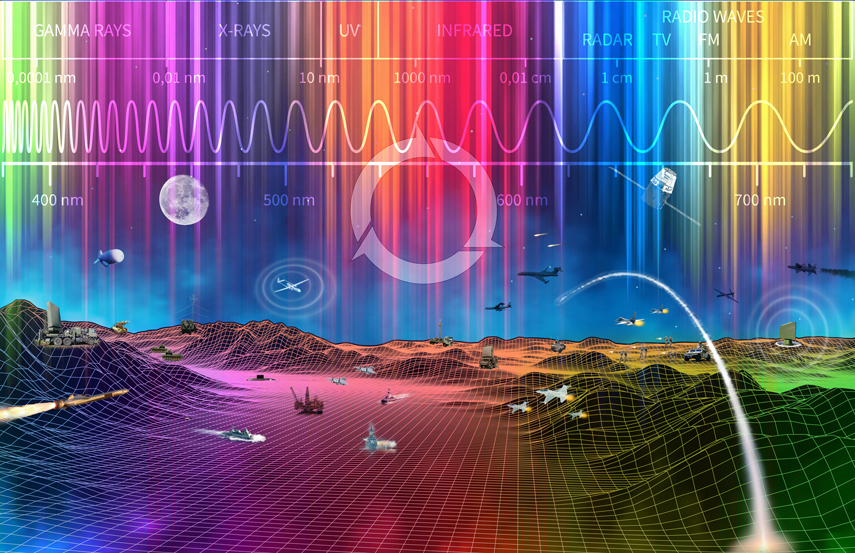This post is also available in:
 עברית (Hebrew)
עברית (Hebrew)
The electromagnetic (EM) spectrum is used by a wide variety of systems, commonly referred to as “spectrum dependent systems” (SDSs). Each SDS may transmit and/or receive EM signals. Examples for SDSs include communication systems, global navigation satellite systems (GNSS), radars, signals intelligence (SIGINT) systems, electronic warfare (EW) systems, communication jammers (COMJAM), and GNSS jammers / spoofers.
The sheer number and diversity of SDSs have increased dramatically over the last few years, both in the civilian arena and in the battlefield. Relevant commercial megatrends include: The massive proliferation of cellular networks and the continuous increase in number of users and bandwidth allocation. For example, in the USA, the Federal Communications Commission (FCC) has already released multiple frequency ranges for fifth-generation (5G) cellular network use, including a total of several GHz of high-band spectrum (above 6 GHz), not used by previous cellular generations.
Large communication satellite constellations becoming a reality, e.g., Starlink by SpaceX, which already consists of over 2,500 mass-produced satellites using Ku-, Ka-, and E- bands. Another example is OneWeb, with over 400 operational satellites employing Ku-band.
The recent emergence of the internet of things (IoT), involving a very high number of SDSs per unit area in urban and suburban areas.
The mobility transformation, expected to lead to numerous autonomous vehicles, unmanned aircrafts (UAs or drones), and electric vertical take-off and landing (eVTOL) vehicles, each requiring wideband data communication.
The modern battlefield is affected by these and other technologies, used by nearby civilian population. In addition, there are several trends unique to military forces, such as: The digital transformation, resulting in the connection of more and more systems to wireless communication networks and the deployment of new advanced networks.
The expansion of utilization of small airborne, shipborne, and ground-based platforms with varying degrees of autonomy, some of which operating in complex radio-frequency (RF) environments, e.g., in dense urban areas and/or indoors.
The significant increase in the quantity and variety of RF sensors and jammers, addressing the rising volume and complexity of the threats.
Note that some countries are also exploring spectrum sharing between government and civilian entities. For instance, the US Department of Defense has been holding experiments demonstration dynamic spectrum sharing between airborne radar systems and 5G cellular networks.
The aforementioned developments lead to ever growing spectral congestion, and an acute need for spectrum management systems (SMSs).
Spectrum Management Requirements
Given the challenges described above, SMSs must adhere to four fundamental requirements, each of which is further described below:
Spectrum management and operational mission planning/management must be intertwined.
Situational awareness is a cornerstone of spectrum management.
SMSs have to be able to respond to rapid changes in the environment.
SMSs should employ hierarchical architecture and edge computing.
Spectrum Management and Operational Mission Planning/Management Must be Intertwined
Classic SMSs typically address spectral conflicts by updating the allocation of transmission frequencies, waveforms/modulations, and/or polarization configurations. However, de-confliction may also be achieved by changing the SDS geometry (including SDS location, orientation, trajectory, and so forth), which is typically determined using operational mission planning/management systems (OMPSs).
Since mutual interference may occur between SDSs associated with different operational missions, achieving optimal overall operational performance requires the integration of multiple OMPSs (each of which relating to one or more operational missions) together with an SMS.
Situational Awareness is a Cornerstone of Spectrum Management
The battlefield is dynamic and unpredictable. This applies not only to the deployment/trajectories and operational configurations of military forces and systems, but also to spectrum utilization by civilian and military SDSs.
Moreover, theoretical path-loss estimation is often inaccurate. Typical tools yield error standard deviations of 7 dB and 15 dB in open and urban areas respectively. Without taking RF measurements in the field, one can either achieve low mutual interference (using worst-case assumptions for the interference level) or efficient spectrum utilization (assuming lower interference levels), but not both.
Consequently, spectrum management cannot be primarily based on a-priori assumptions. Continuous situational awareness should be a key component of SMS design. Situational awareness may be obtained using various information sources, including spectral sensors, SIGINT systems, measurements made by various SDSs and reported to the SMS in real-time, human intelligence, and so forth.
SMSs Have to be Able to Respond to Rapid Changes in the Environment
As explained above, SMSs are required to respond to changes in the environment. Such changes may be rapid. For instance, hypersonic weapons may reach a speed of about 8 km/sec, and are also highly maneuverable. Even civilian drones can be quite fast, e.g., the DRL Racer X reaches a top speed of approximately 290 km/hr.
Spectral changes are often much faster than that. Many communications systems employ frequency hopping, changing the transmission frequency numerous times per second. For example, the typical symbol duration for Long-Term Evolution (LTE) base-stations is 71 μsec. Certain 5G base-station configurations can even generate multiple different beam-patterns, and each user-equipment chooses the most suitable beam pattern at a certain rate (e.g., every 20 msec). Looking at the near future, military systems are expected to adopt more and more technologies with these capabilities, forcing military spectrum managers to address the operational implications.
In conclusion, at least for some applications, SMSs should support sub-second response times.
SMSs Should Employ Hierarchical Architecture and Edge Computing
Transferring all relevant information to a regional or central SMS is impractical, since the latency of presently available communications networks does not support the aforementioned short response times. Such response times can only be achieved by edge computing, i.e., performing some of the computations at or near the SDSs themselves.
Nevertheless, regional and/or central processing is also advantageous. It allows SMSs and SMS operators to evaluate the bigger picture and perform global optimization (with more information sources and resources under control). It also enables the exploration of multiple alternative solutions for achieving operational goals. For instance, an enemy missile may be addressed by an interceptor or a laser weapon system, but also by COMJAM or GNSS jammer/spoofer. Each of these options has different implications in terms of spectral allocation. Regional/central processing therefore provides decision makers with spectrum maneuverability, maximizing SDS effectiveness and overall operational performance.
The most effective SMS design probably involves a hierarchical architecture, with both regional/central processing and edge computing, enabling to optimally balance the tradeoffs between spectrum use efficiency and operational capacity.
Summary
Both civilian and military spectrum utilization have been revolutionized in recent years, and further significant changes are expected in the near future. This tectonic shift must be taken into account in the design of spectrum management systems.
Prepared to dive into the world of futuristic technology? Attend INNOTECH 2023, the international convention and exhibition for cyber, HLS and innovation at Expo, Tel Aviv, on March 29th-30th
Interested in sponsoring / a display booth at the 2023 INNOTECH exhibition? Click here for details!


























